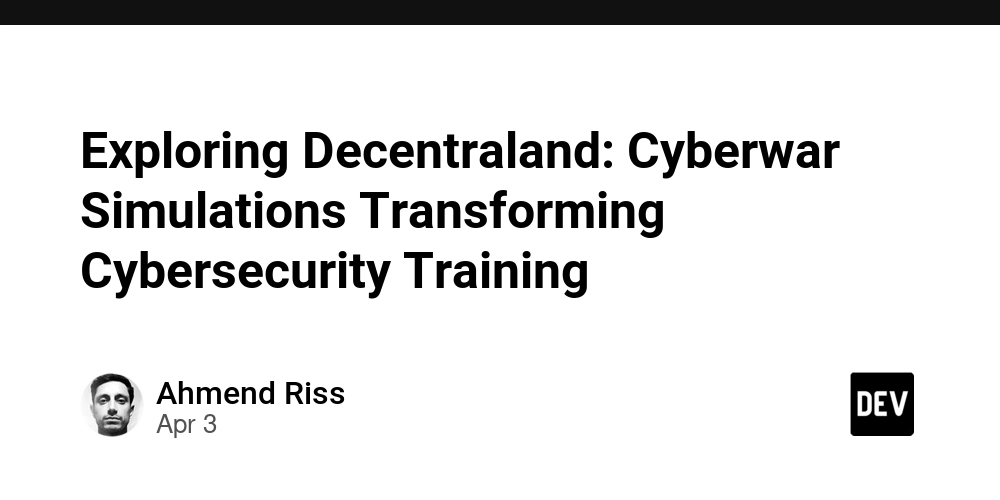Exploring Decentraland: Cyberwar Simulations Transforming Cybersecurity Training
Abstract This post explores how Decentraland—a decentralized virtual world built on the Ethereum blockchain—is revolutionizing cybersecurity training through immersive cyberwar simulations. We discuss the background and context of blockchain-powered virtual environments, detail the core simulation concepts like offensive "red teams" and defensive "blue teams," provide real-world applications and use cases, examine challenges and limitations, and look into future trends in cybersecurity and virtual training. With insights from blockchain, cybersecurity education, and open source communities, this post offers a technical yet accessible overview for professionals and enthusiasts alike. Introduction Cybersecurity training is evolving rapidly with the introduction of immersive digital training environments. One such transformative initiative takes place in Decentraland, a decentralized, user-driven virtual world that leverages blockchain technology for secure and transparent experiences. By integrating cyberwar simulations into its ecosystem, Decentraland provides a dynamic sandbox where participants can train for real-world cybersecurity challenges. This post offers a comprehensive exploration of how these simulations work, why they are essential, and how innovations in blockchain and open source technology are setting new standards in cybersecurity education. Background and Context The Rise of Virtual Training Environments Traditional cybersecurity training often relies on static environments and scripted exercises. However, with the rising sophistication of cyber threats, there is a pressing need for realistic, high-fidelity simulations. Decentraland addresses this requirement by combining a decentralized economy—powered by NFTs—with immersive virtual experiences. The integration of blockchain, as explained in What is Blockchain, ensures that every simulation step is recorded in an immutable ledger, providing transparency and trust. Evolution of Cyberwar Simulations Cyberwar simulations are designed to mimic the complexities encountered during actual cyber conflicts. These exercises involve: Red Teams: Offensively testing the system by simulating attacks. Blue Teams: Defensively safeguarding systems and responding in real time. This interplay creates a double-edged learning environment that sharpens both proactive and reactive security strategies. Educational institutions and enterprises are now increasingly turning to these real-world simulations to improve detection, response time, and overall cybersecurity preparedness. The Blockchain Ecosystem in Virtual Worlds Blockchain’s role in powering decentralized environments extends beyond asset ownership. It secures every transaction and interaction, establishing a clear audit trail. In a simulation context, this means that: Real-time events are transparently logged. Immutable records support post-simulation analysis. Secure and decentralized protocols protect sensitive training data. This integration boosts confidence for both professionals and educational institutions, making platforms like Decentraland ideal for conducting advanced cybersecurity training exercises. Core Concepts and Features The innovative approach of Decentraland in transforming cybersecurity training is based on several core concepts and features: 1. Immersive Cyberwar Simulations Decentraland offers simulations that replicate real-world cyber conflict scenarios with high fidelity. These virtual exercises use realistic threat models to stress-test participants’ abilities to identify and counteract cyber attacks. 2. Red Teams and Blue Teams Red Teams: Simulate advanced intrusion techniques and attack vectors, allowing participants to understand the offensive side of cyber warfare. Blue Teams: Develop defensive strategies and monitor systems to detect and neutralize attacks. This duality ensures a balanced training exercise with immediate feedback loops. 3. Blockchain-Based Integrity Every action taken during a simulation is recorded on the blockchain, ensuring the integrity of the training process. This tamper-proof logging supports both real-time monitoring and retrospective analysis, essential for refining future strategies. 4. NFT-Driven Economic Models Decentraland’s economy is driven by NFTs, making it possible for businesses and communities to monetize experiences. This includes not only virtual real estate and digital collectibles but also licensing training modules and simulation scenarios. For more on NFT viability, read What are NFTs. 5. Open Source Integration By leveraging open source tools and frameworks, Decentraland’s simulation environment encourages community-driven innovations and collaborative development. Resources like the Open Source Tools in Cyber Warfare illustrate how collaborative efforts can accelerate security

Abstract
This post explores how Decentraland—a decentralized virtual world built on the Ethereum blockchain—is revolutionizing cybersecurity training through immersive cyberwar simulations. We discuss the background and context of blockchain-powered virtual environments, detail the core simulation concepts like offensive "red teams" and defensive "blue teams," provide real-world applications and use cases, examine challenges and limitations, and look into future trends in cybersecurity and virtual training. With insights from blockchain, cybersecurity education, and open source communities, this post offers a technical yet accessible overview for professionals and enthusiasts alike.
Introduction
Cybersecurity training is evolving rapidly with the introduction of immersive digital training environments. One such transformative initiative takes place in Decentraland, a decentralized, user-driven virtual world that leverages blockchain technology for secure and transparent experiences. By integrating cyberwar simulations into its ecosystem, Decentraland provides a dynamic sandbox where participants can train for real-world cybersecurity challenges. This post offers a comprehensive exploration of how these simulations work, why they are essential, and how innovations in blockchain and open source technology are setting new standards in cybersecurity education.
Background and Context
The Rise of Virtual Training Environments
Traditional cybersecurity training often relies on static environments and scripted exercises. However, with the rising sophistication of cyber threats, there is a pressing need for realistic, high-fidelity simulations. Decentraland addresses this requirement by combining a decentralized economy—powered by NFTs—with immersive virtual experiences. The integration of blockchain, as explained in What is Blockchain, ensures that every simulation step is recorded in an immutable ledger, providing transparency and trust.
Evolution of Cyberwar Simulations
Cyberwar simulations are designed to mimic the complexities encountered during actual cyber conflicts. These exercises involve:
- Red Teams: Offensively testing the system by simulating attacks.
- Blue Teams: Defensively safeguarding systems and responding in real time.
This interplay creates a double-edged learning environment that sharpens both proactive and reactive security strategies. Educational institutions and enterprises are now increasingly turning to these real-world simulations to improve detection, response time, and overall cybersecurity preparedness.
The Blockchain Ecosystem in Virtual Worlds
Blockchain’s role in powering decentralized environments extends beyond asset ownership. It secures every transaction and interaction, establishing a clear audit trail. In a simulation context, this means that:
- Real-time events are transparently logged.
- Immutable records support post-simulation analysis.
- Secure and decentralized protocols protect sensitive training data.
This integration boosts confidence for both professionals and educational institutions, making platforms like Decentraland ideal for conducting advanced cybersecurity training exercises.
Core Concepts and Features
The innovative approach of Decentraland in transforming cybersecurity training is based on several core concepts and features:
1. Immersive Cyberwar Simulations
Decentraland offers simulations that replicate real-world cyber conflict scenarios with high fidelity. These virtual exercises use realistic threat models to stress-test participants’ abilities to identify and counteract cyber attacks.
2. Red Teams and Blue Teams
- Red Teams: Simulate advanced intrusion techniques and attack vectors, allowing participants to understand the offensive side of cyber warfare.
- Blue Teams: Develop defensive strategies and monitor systems to detect and neutralize attacks. This duality ensures a balanced training exercise with immediate feedback loops.
3. Blockchain-Based Integrity
Every action taken during a simulation is recorded on the blockchain, ensuring the integrity of the training process. This tamper-proof logging supports both real-time monitoring and retrospective analysis, essential for refining future strategies.
4. NFT-Driven Economic Models
Decentraland’s economy is driven by NFTs, making it possible for businesses and communities to monetize experiences. This includes not only virtual real estate and digital collectibles but also licensing training modules and simulation scenarios. For more on NFT viability, read What are NFTs.
5. Open Source Integration
By leveraging open source tools and frameworks, Decentraland’s simulation environment encourages community-driven innovations and collaborative development. Resources like the Open Source Tools in Cyber Warfare illustrate how collaborative efforts can accelerate security technology advancements.
Table: Key Features of Decentraland Cyberwar Simulations
| Feature | Description | Benefit |
|---|---|---|
| Immersive Environment | Virtual world powered by blockchain technology | Realistic simulation, enhanced engagement |
| Red & Blue Teams | Dual training approach involving offensive and defensive strategies | Holistic understanding of cyber warfare tactics |
| Immutable Audit Trails | Every simulation action is recorded on the blockchain | Improved transparency and post-simulation analysis |
| NFT Economic Model | Uses NFTs to monetize digital assets and training experiences | Incentivizes community involvement and sustainability |
| Open Source Integration | Leverages open source tools for development and innovation | Accelerates improvements and reduces adoption barriers |
Applications and Use Cases
Cyberwar simulations in Decentraland provide several tangible benefits for different sectors:
A. Educational Institutions
Universities and technical schools can incorporate these simulations into their curriculum to offer hands-on learning. Students not only study theoretical cybersecurity principles but also get a chance to apply them in realistic settings. Institutions like Cybersecurity Education are already taking steps to integrate these digital training innovations into their programs.
B. Corporate Cybersecurity Training
Large enterprises confront constant cyber threats. Using Decentraland’s blockchain-powered training, companies can simulate a variety of attack scenarios without compromising real systems. This “sandbox” allows IT teams to test and refine their response protocols, equipping them to handle live attacks more effectively.
Bullet List: Benefits for Corporates
- Risk-Free Testing: Simulated environments ensure no real-world data is compromised.
- Rapid Response Training: Teams learn to identify, contain, and mitigate threats in real time.
- Strategic Preparedness: Iterative feedback and analysis enhance long-term security strategies.
C. Government and Defense Applications
With national security increasingly influenced by digital warfare, government agencies have started exploring virtual training platforms like Decentraland. Through these simulations, defense teams can practice scenarios that mirror high-stakes cyber conflicts, improving strategic readiness.
Expert Insights from the Open Source Community
The synergy between blockchain technology, cybersecurity, and open source is also underscored in posts from industry experts. For instance, the article Blockchain and Open Source Revolutionizing Innovation highlights how decentralized governance can foster trust in virtual ecosystems. Similarly, Decentralized Governance in Open Source: Bridging Innovation and Community offers insights into how these innovative models can be adapted to cybersecurity training frameworks.
Challenges and Limitations
Despite its promise, the integration of cyberwar simulations in virtual worlds is not without challenges:
1. Technical Complexity
Developing realistic simulation scenarios requires advanced simulation engines and robust blockchain infrastructure. Ensuring that these simulations mirror real-world attack patterns while maintaining system performance is a significant technical hurdle.
2. Adoption Barriers
While many tech-savvy companies and institutions see the value of advanced simulations, wider adoption is slowed by factors such as cost, resistance to change, and the learning curve associated with new technologies. Legacy systems and traditional training methodologies may present integration issues.
3. Data Privacy and Security
Blockchain provides immutability and transparency. However, ensuring that sensitive training data remains secure on a public ledger is an ongoing concern. Rigorous data protection measures and adherence to privacy regulations are essential for maintaining trust within these systems.
Bullet List: Key Challenges
- Integration Complexity: Bridging legacy systems with blockchain-based virtual worlds.
- Cost Implications: High initial setup and training costs.
- Data Security: Balancing transparency with the need for confidentiality.
- User Adoption: Overcoming resistance to new training methodologies.
4. Regulatory and Ethical Considerations
As cyberwar simulations become more integrated into training programs, regulatory frameworks must evolve. Ethical questions around the militarization of virtual worlds and the potential misuse of simulation data remain central to discussions among experts and policymakers.
Future Outlook and Innovations
The future of cybersecurity training in virtual worlds like Decentraland looks promising, with several anticipated trends and innovations:
A. Integration with AI and Machine Learning
Artificial intelligence and machine learning are poised to enhance simulation realism by predicting attacker behavior and offering adaptive defense strategies. These innovations could significantly improve the training outcomes by providing personalized, real-time feedback.
B. Enhanced Interoperability and Cross-Chain Capabilities
As blockchain ecosystems evolve, interoperability between various chains could lead to more diverse training modules and cross-platform simulations. Projects like Arbitrum and Cross-chain Bridges pave the way for seamless integration between different virtual environments.
C. Continued Expansion of NFT Functionality
NFTs are not only digital collectibles but also keys to unlocking training modules, memberships, and access to exclusive simulation environments. With NFT-based licensing and asset ownership, cyberwar simulations could see an entirely new model of monetization and community engagement.
D. Broader Adoption in Public and Private Sectors
In the coming years, more governmental and corporate entities are expected to incorporate virtual simulations into their cybersecurity training curricula. This shift is supported by the growing body of research and practical case studies emerging from platforms like Decentraland and open source communities.
Expert Predictions on Future Trends
The post The Future of Digital Art Merging Blockchain, NFTs and Open Source Sustainability provides compelling insights into how virtual worlds and blockchain can integrate to drive sustainable innovation. Additionally, perspectives shared in Navigating the Intricate World of Open Source Licensing in Cyberwarfare underline the importance of regulatory and ethical frameworks in fostering innovation.
Table: Future Innovations Roadmap
| Innovation Area | Potential Benefits | Timeline |
|---|---|---|
| AI & ML Integration | Enhanced simulation realism and adaptive training | Short to Mid Term |
| Cross-Chain Interoperability | Diverse training modules and broader ecosystem connectivity | Mid Term |
| NFT Extensions | New monetization models and ownership of training licenses | Ongoing |
| Regulatory Frameworks | Standardized guidelines ensuring ethical use of simulations | Long Term |
Summary and Conclusion
Decentraland is at the forefront of a cybersecurity training revolution. By bringing together blockchain technology, immersive cyberwar simulations, and a vibrant open source community, it presents a transformative model for real-world security preparedness. The use of offensive and defensive teams in highly realistic simulations helps organizations identify vulnerabilities, refine strategies, and develop robust response mechanisms against sophisticated cyber threats.
This comprehensive approach—backed by immutable blockchain records and innovative NFT integration—ensures that every training exercise is both secure and scalable. Although challenges such as technical complexity and data privacy persist, the potential for integrating AI, cross-chain capabilities, and enhanced regulatory frameworks promises a bright future for virtual cybersecurity training.
As more educational institutions, corporations, and governments adopt these advanced simulations, the landscape of cybersecurity training will continue to evolve. The blend of practical experience with cutting-edge technological advancements makes platforms like Decentraland not only critical for today’s digital defenders but also a beacon for the future of cybersecurity education.
For further reading and deeper insights, be sure to explore related resources such as Decentraland Cyberwar Simulations and authoritative discussions on Blockchain and Open Source. Additional perspectives on decentralized governance and the economic impact of NFTs are also available in posts like Decentralized Governance in Open Source: Bridging Innovation and Community.
In summary, Decentraland’s cyberwar simulations create an unparalleled convergence of gaming, learning, and real-world cybersecurity strategy. With transparent, blockchain-backed training and the collaborative ethos of open source initiatives, the future of cybersecurity training is not only transformative but also inclusive and resilient.
Embrace the future of cybersecurity training—where innovative simulation meets technological rigor, and every lesson learned fortifies our digital defenses in a rapidly evolving cyber landscape.
Whether you are a cybersecurity professional, academic, or technology enthusiast, the insights shared in this post underscore the growing relevance of virtual training platforms like Decentraland. The convergence of immersive simulation, blockchain security, and community-driven open source innovation is paving the way for next-generation defense strategies. Stay ahead of cyber threats by exploring and engaging with these transformative technologies.













































































